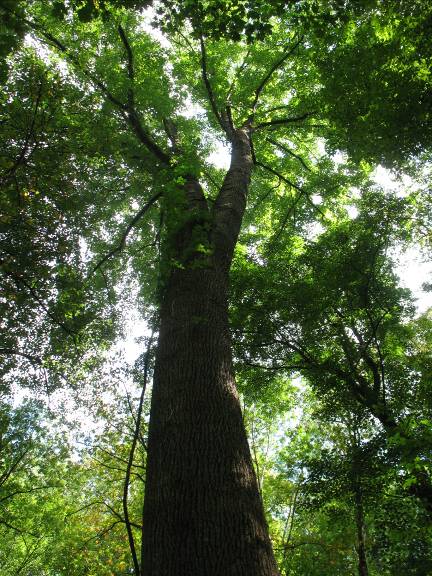|
==============================================================================
TOPIC: Jess Riddle does it again- new tuliptree height record!
http://groups.google.com/group/entstrees/browse_thread/thread/0ff51fabb042907d?hl=en
==============================================================================
== 1 of 2 ==
Date: Sun, Sep 21 2008 8:08 am
From: "Will Blozan"
ENTS,
Yesterday I had an opportunity to visit a tuliptree Jess Riddle told
me
about last year. His laser measurements strongly indicated the tree
could be
a new height record for the species. Additionally, this tree could
represent
the second species in the eastern US capable of obtaining 180 feet
tall.
Only eastern white pine has been found over 180 feet tall- and only
seven
trees so far. Tuliptree has skirted close to the 180 mark for over a
decade
with several specimens over 177 feet, with 178.2 feet the highest
recorded
tree. Jess had this tree somewhere between ~178 and ~181 feet. It
has had
two growing seasons since it was last measured.
I was joined on my search yesterday by David Huff of Back 40 Films
(he is
shooting the "Vanishing Hemlock" documentary). Map in hand
we headed to find
an unnamed tributary of Bradley Fork in the Oconaluftee District of
Great
Smoky Mountains National Park. The sheltered topography, rich soils
and
ideal elevation range was arguably one of the most perfect locations
for
tall hardwoods. In fact, this is how Jess came to search the area.
His
prediction was right- he found a section of "older" forest
(still quite
young, ~100-120 years- logged heavy) with impressive canopy height.
Dave and I selected a crossing point to access the cove. We took a
several
hour detour in the wrong cove which we found out was probably less
than 200
feet from the correct cove. The first cove we explored was young
second-growth (>90 years) with a scattering of 150' tuliptrees
(one was
164'). We found and measured a fine black oak at 31.1 inches
diameter and
135.1 feet tall. I believe this is the second tallest in the Smokies,
with a
137 footer in Big Creek. Discouraged, we headed downstream to try to
intersect with the creek that supposedly drained the cove we wanted.
No
luck- there was no drainage and we missed the cove again. It was
getting
late but considering the effort and cost to drive there again we
decided to
try once more, and went upslope to intersect the drainage higher up.
That
worked! We found the drainage easily and found that the topo map was
useless
and reflected nothing useful on the ground.
The correct cove was obviously older and more diverse. The herb
layer was
very well developed and the diverse herbs plus shrubs like spicebush
indicated rich soils. Instantly, tall trees emerged with the first
tree
measured a 34.3" X 154.9' sycamore. Another sycamore upstream
was no les
than 153'. Jess's tuliptree had the distinctive characteristic of
having a
huge, flattened (and dangerously weak.) "pancake" of wood
where two huge
bifurcations forked from the main trunk. With that image in mind,
the tree
was easily spotted several hundred feet away.

Jess Riddle's photo in winter 2007. Fork on left is tallest

Tree canopy 9-20-2008. Fork on right is tallest
The tree was far larger than I thought. It truly dominates the
small,
incised drainage where it grows. I went upslope to get a sighting on
the top
while Dave set up a pole at the base to get a target above the basal
clutter. I found a blowdown with a full view of the broad top. The
southwest
side was clearly taller and I isolated the highest tip out of 6-7
tops. I
shot the top, the basal target and cross-checked my angles and
distances
multiple times. I settled on the most consistent, repeated readings
and then
went to the base to measure the midslope point and the basal target.
All
said and done the height of this 52.7" diameter tree came out
to 181.9 feet.
Allowing for instrument resolution, I calculated the resulting
height if the
laser was 0.5 yards long and the clinometer 0.1 degree over on both
top and
basal shots. In reality, the clinometer should cancel itself out
since the
angles were very similar. Of course, the instruments could have read
short
but this typically has not been the case in other trees I have
measured and
then climbed. Range of height with possible equipment error:
If laser reading high, clinometer good= 180.8'
If laser good, clinometer reading high= 181.3'
If both laser and clinometer high= 180.4'

Thus, tuliptree has now joined the "180 Club" and shares
this spot with
white pine as the only other member. This brings the GRSM Rucker
index to
167.3! Jess and I plan to climb and model this tree this December
and
perform a tape drop for absolute accuracy. There is more to explore
higher
in the cove and two trees near the tall one are not less than 173.4
and
177.3 feet tall.
GRSM
Rucker Index 9/20/2008
|
Species
|
Height
|
|
E.
white pine
|
188.8
|
|
Tuliptree
|
181.9
|
|
E.
hemlock (dead)
|
173.1
|
|
Black
locust
|
171.8
|
|
White
ash
|
167.1
|
|
A.
sycamore
|
162.2
|
|
Pignut
hickory (red?)
|
159.7
|
|
Yellow
buckeye
|
157.3
|
|
Bitternut
hickory
|
156.3
|
|
Red
spruce
|
155.3
|
|
|
167.35
|
Will F. Blozan
President, Eastern Native Tree Society
President, Appalachian Arborists, Inc.
== 2 of 2 ==
Date: Sun, Sep 21 2008 10:35 am
From: Larry
Will, Wow! A 180 Tulip thats awesome!. Congrats to You and Jess.
Sounds like a great to place to visit! Awesome heights given the
Forest is only 100-120! Larry
==============================================================================
TOPIC: Jess Riddle does it again- new tuliptree height record!
http://groups.google.com/group/entstrees/browse_thread/thread/0ff51fabb042907d?hl=en
==============================================================================
== 1 of 1 ==
Date: Wed, Sep 24 2008 2:57 pm
From: Michael Davie
Right on! Bradley Fork does it again! Nice job, it's great to have
the
first (and probably not the last) one that breaks 180.
|